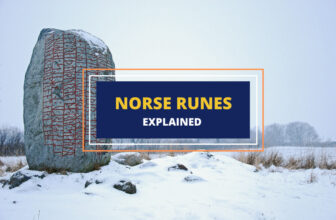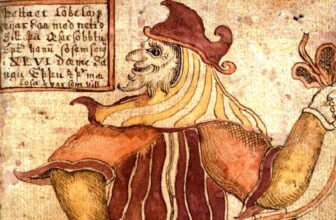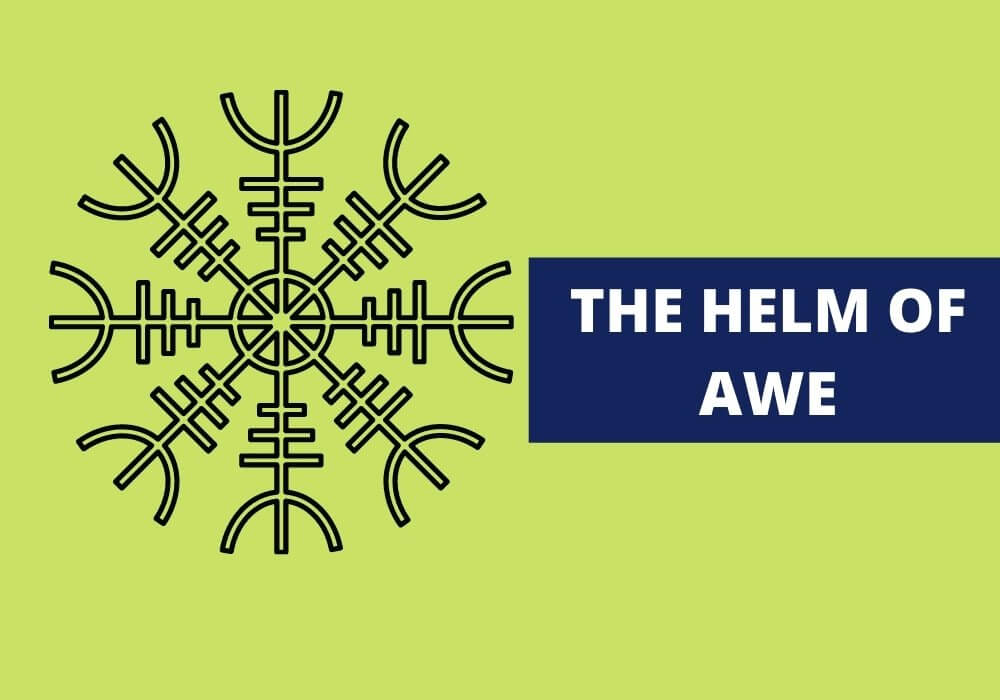
Table of Contents
The Helm of Awe. The name itself sounds remarkable and powerful. Yet it is known by a range of other names such as the Helm of Terror, Aegishjalmur, and the Viking Compass. It sounds as though it is an object that should be venerated and is one of the most mysterious and powerful symbols of Norse mythology.
But what exactly is the Helm of Awe and what has it come to symbolise? Let’s take a journey back into the old Norse country and the Vikings to discover what the Helm of Awe was and if the meaning behind this Nordic icon has changed over time.
Helm of Awe Origins

The Helm of Awe features in Norse mythology as both a physical and a metaphorical object. It’s mentioned in many Norse myths, literary pieces and legends.
1- Fafnir the Dragon and the Helm of Awe
The Poetic Edda is a compilation of Ancient Nordic poems and it is in this publication that we find an initial mention of the Helm of Awe. It is written that the dragon Fafnir believed he would become invincible if he had the emblem of the Helm of Awe. The association of Fafnir with the Helm of Awe may be through an understanding that the Helm was linked to serpents.
2- The Völsunga Saga
In Chapter XIX of this classic Nordic poem, an account is made of Sigurd, after defeating Fafnir, looting Fafnir’s goods and finding among them – the Helm of Awe. This lends itself to the belief that the Helm of Awe was a physical object. And if you’re wondering why Fafnir was defeated if he had the Helm of Awe, it was because he let his guard down by not bearing the Helm of Awe. This carries the idea that, without the Helm of Awe, you are open to being taken down by your enemies.
3- The Vikings and the Helm of Awe
Following the belief that anyone who bore the symbol of the Helm of Awe would become invincible, the Vikings wore it on their foreheads as they entered into battle. Also, they believed that it would strike terror into those who saw them coming with the Helm of Awe on their brow, which can be seen as similar to the understanding of the prey of serpents being paralyzed by serpentine power.
The Helm of Awe – Physical or Metaphorical?
From all the sagas and poems that stem from the old Nordic traditions, there are some that claim the Helm of Awe was an object.
This can be seen in the legends where Fafnir the Dragon believed that it made him invincible if he had the Helm with him. Also, Sigurd takes the Helm of Awe from Fafnir’s possessions. This indicates that the Helm of Awe was an actual object – at least in the myths.
However, it also correlates to a symbol, which was often used in tattoo designs, painted on vessels and used as an amulet. This indicates a belief that the Helm of Awe was something tangible that was possessed of great power for those who bore it.
Other scholars suggest that the Helm is merely a metaphor for a covering – an umbrella of divine protection and that the icon simply indicates that.
What does the Helm of Awe Image Represent?
There are several variations of the Helm of Awe, but the more traditional version is of eight tridents all protruding out threateningly from a central point. Another version found in the Galdrabok (an Icelandic grimoire, or a book of magic spells) has four tridents.
1- The Trident of the Helm of Awe
The tridents that emanate from the centre of the Helm of Awe bear a similarity to the z rune, or Algiz. If that’s the case, then it was a well thought out move by the original designer of this emblem as the Algiz is believed to represent the might of the universe. Who is more invincible than someone who has the universe and the gods on their side.
The Algiz is a rune that is associated with communication with the divine and the plan the divine has for your life as well as being indicative of spiritual awareness.
Another interpretation of the construction of the tridents is that they are made of Isa runes. Isa runes are associated with Ice as well as a connection to focus and concentration. So, if the tridents are comprised of Isa runes, it can indicate the steely focus and concentration needed to succeed in battle.
The positioning of the tridents is seen to symbolise both an act of defense as well as an offensive attack. It is as though all eight the tridents are protecting the centre point.
2- The circular centre of the Helm of Awe
The circle in the middle of the Helm of Awe symbol is seen to represent protection, both physical and spiritual.
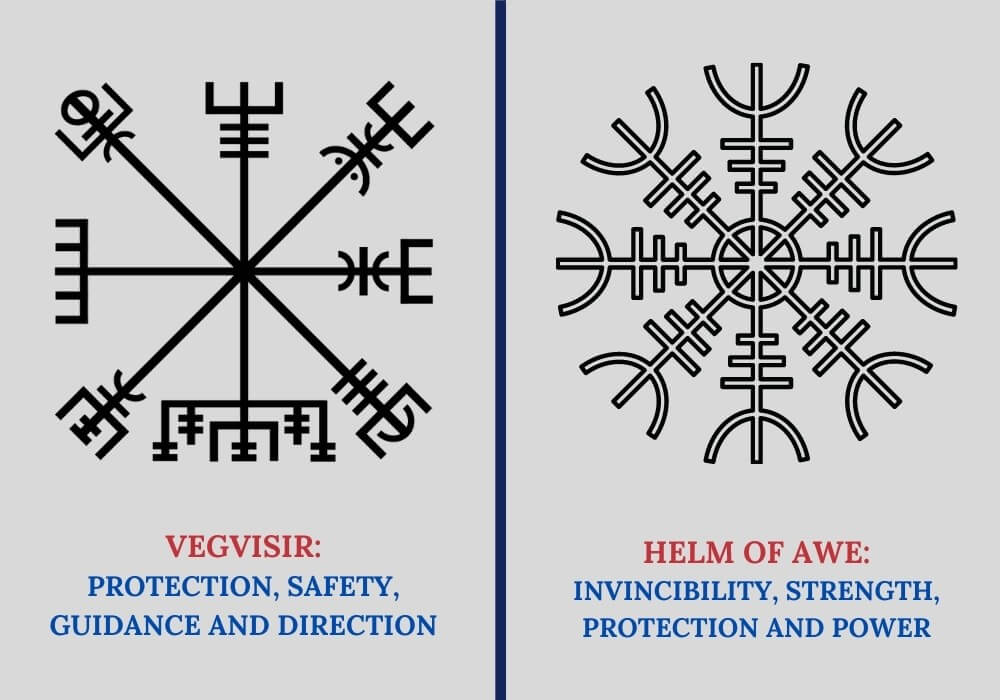
In its design, the Helm of Awe is somewhat similar in appearance to the Vegvisir, which also features eight spokes emerging from a central point, surrounded by runes.
The Vegvisir is also a protective symbol, representing guidance, safety and direction to seafarers. As such, it’s a more universal symbol. However, while similar, the Helm of Awe is a warrior’s symbol, and represents protection and invincibility for a fighter.
The Helm of Awe Variations in Other Beliefs
Though the Helm of Awe has its origination in Nordic folklore, there are similar representations found outside of Norse mythology. The dharma wheel in Buddhism is a classic example.
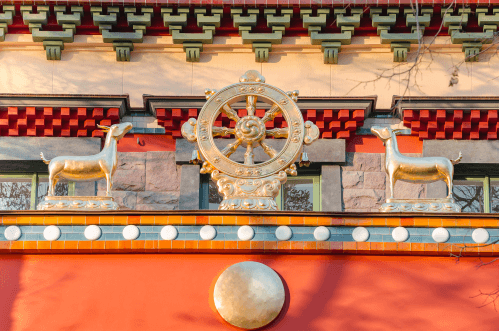
If you compare the eight-spoked dharma wheel with the eight-trident version of the Helm of Awe, you will find a remarkable resemblance between the two. Just as the Helm of Awe indicates protection, so too can the dharma wheel. The wheel symbolizes that as one follows the Eight-fold path of Buddhism one will find that they are also protected against struggles in life.
The Asatru religion, which is a modern revival of the old Nordic beliefs, claims the Helm of Awe as one of their symbols and is considered a reflection of courage and bravery to adhere to one’s own belief. Therefore, the Helm of Awe takes on a spiritual dimension of protection and defence.
For a similar non-religious example, consider the ship’s wheel symbol. This also typically has eight spokes and is a meaningful symbol. The difference, however, is that the ship’s wheel symbol originated from a practical object.
The Helm of Awe in Jewelry and Fashion
The Helm of Awe is often used as a symbol in fashion items, such as clothing and jewelry. For those who feel like they need some assistance in fighting back against life, they may feel that wearing the Helm of Awe will provide them with the success and strength they are seeking for.
Apart from its symbolic meanings, the Helm of Awe is also valued as a symmetrical symbol that can be stylized. This makes it ideal in designs for pendants, charms, earrings and rings. It’s also ideal in metal artwork or on tapestries as wall hangings.
In Brief
The Helm of Awe is seen as an object of great power and protection, guaranteeing anyone that brandished it sure victory in battle. The belief of success in battle goes beyond the physical and into the spiritual where some believe that the Helm of Awe protects and keeps them as they journey through the tougher times in their life. As such, the Helm of Awe continues to be a meaningful symbol, even in modern times.








